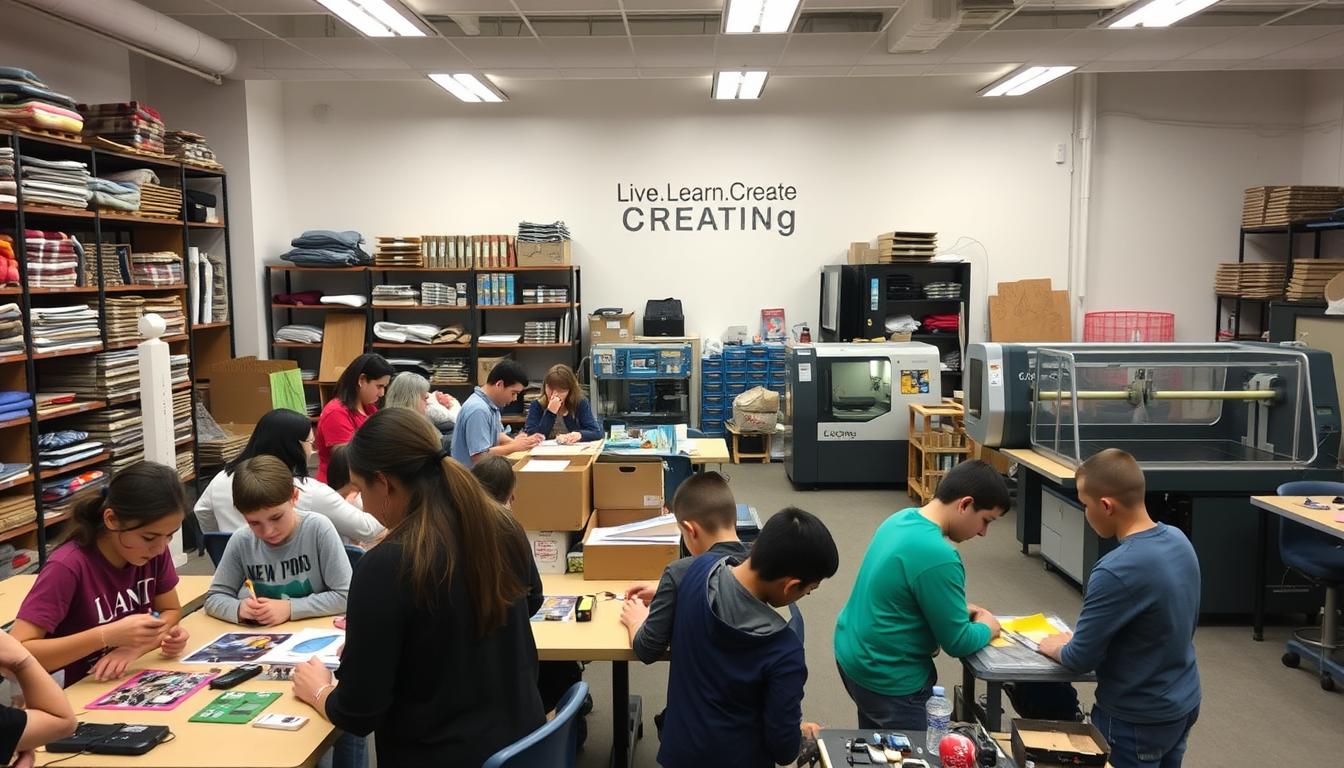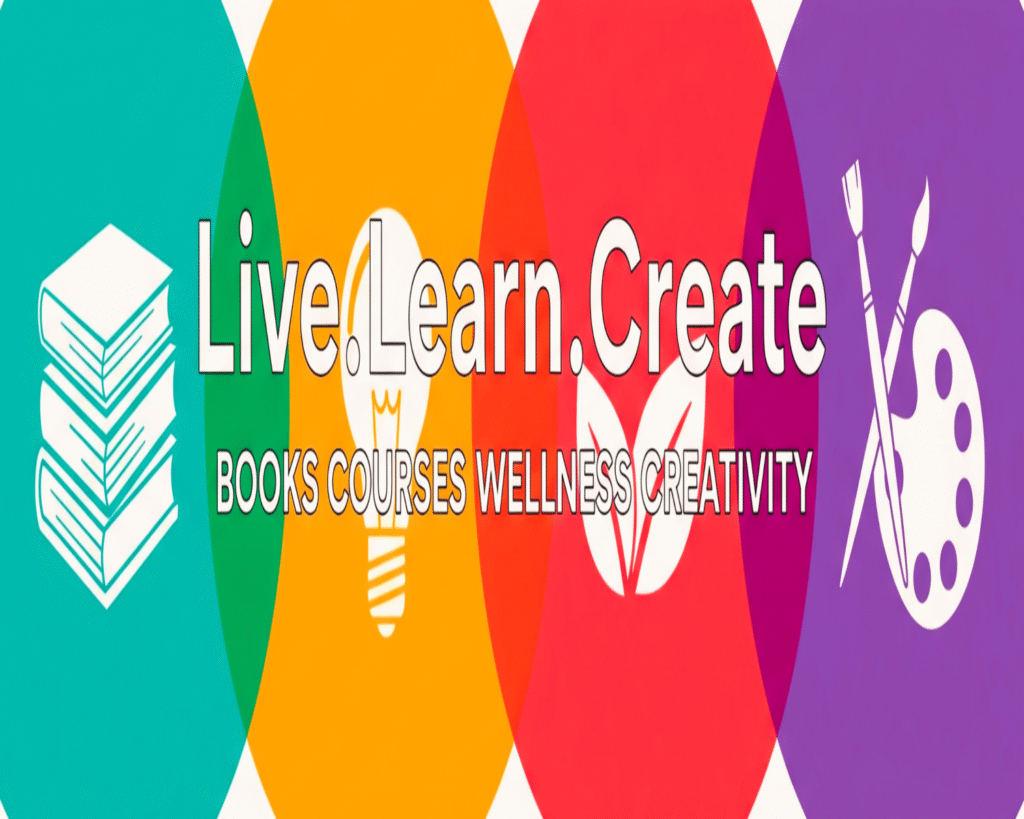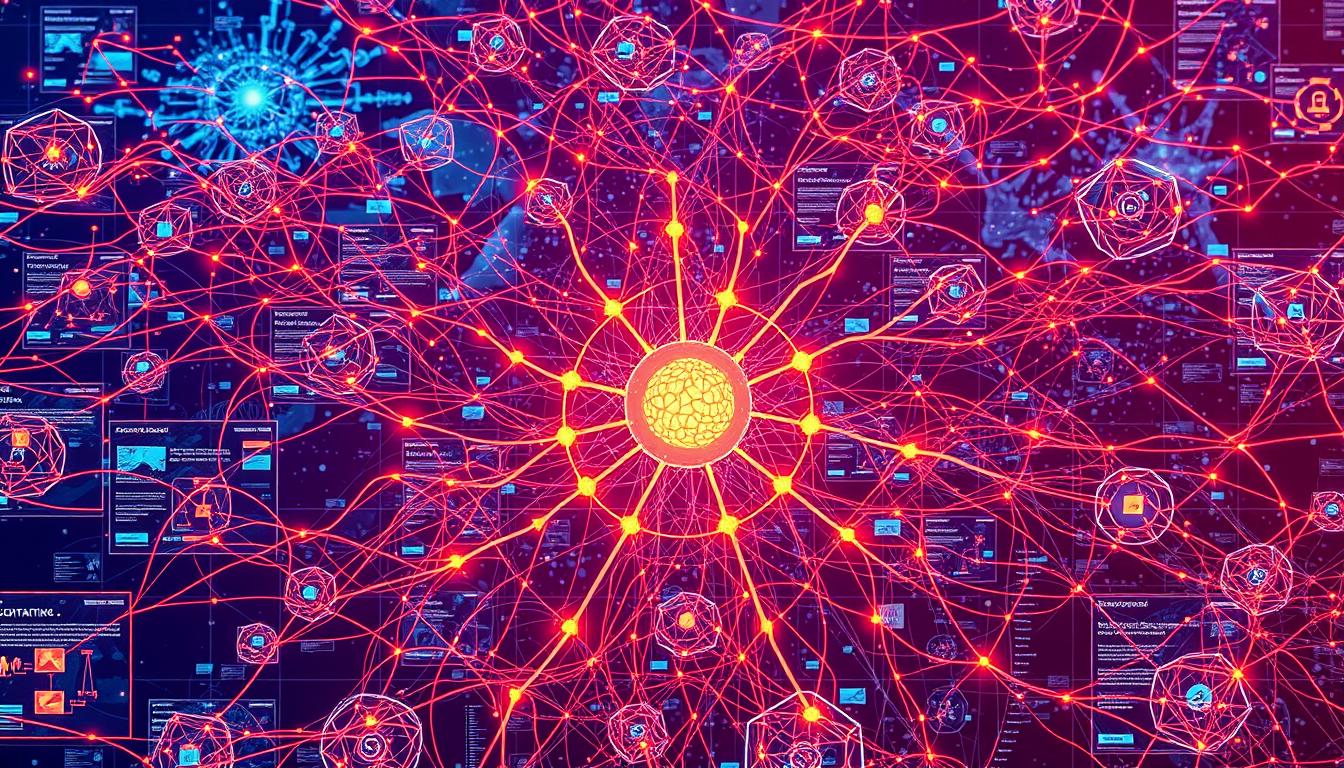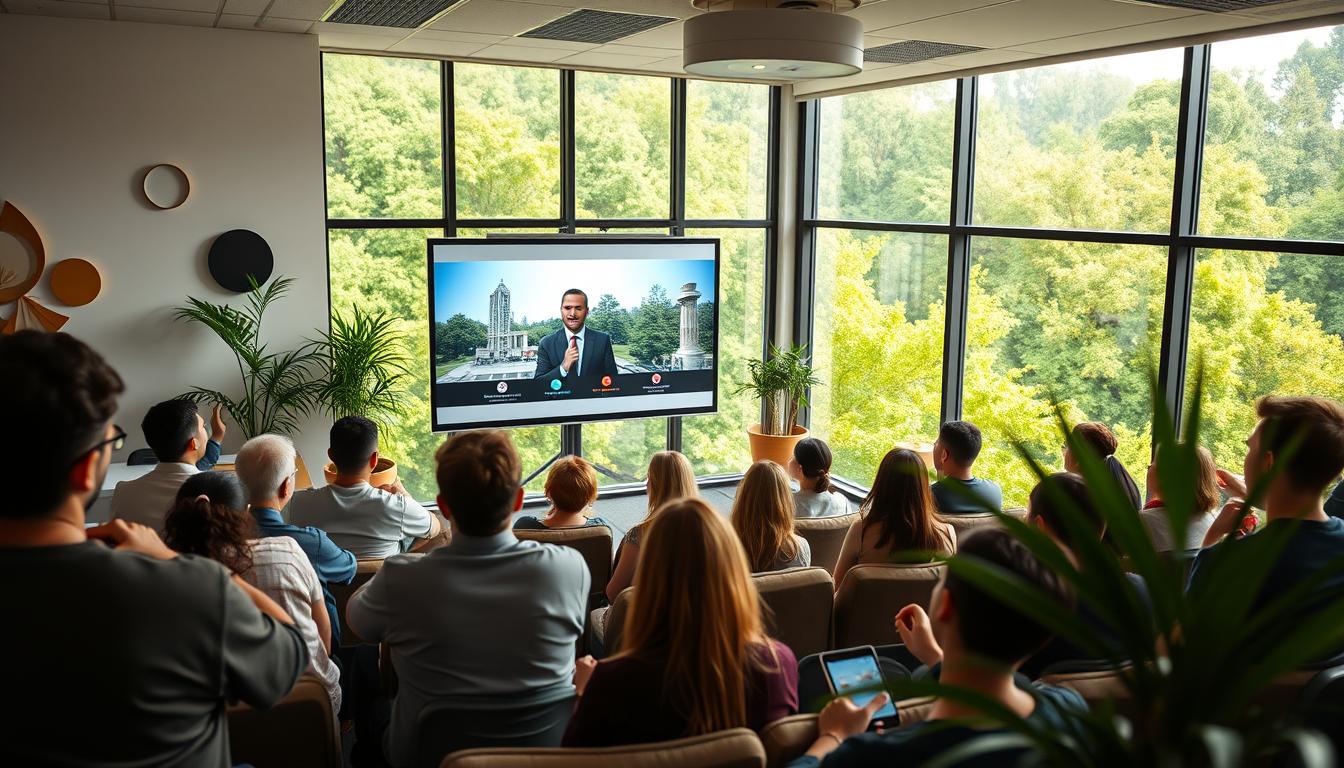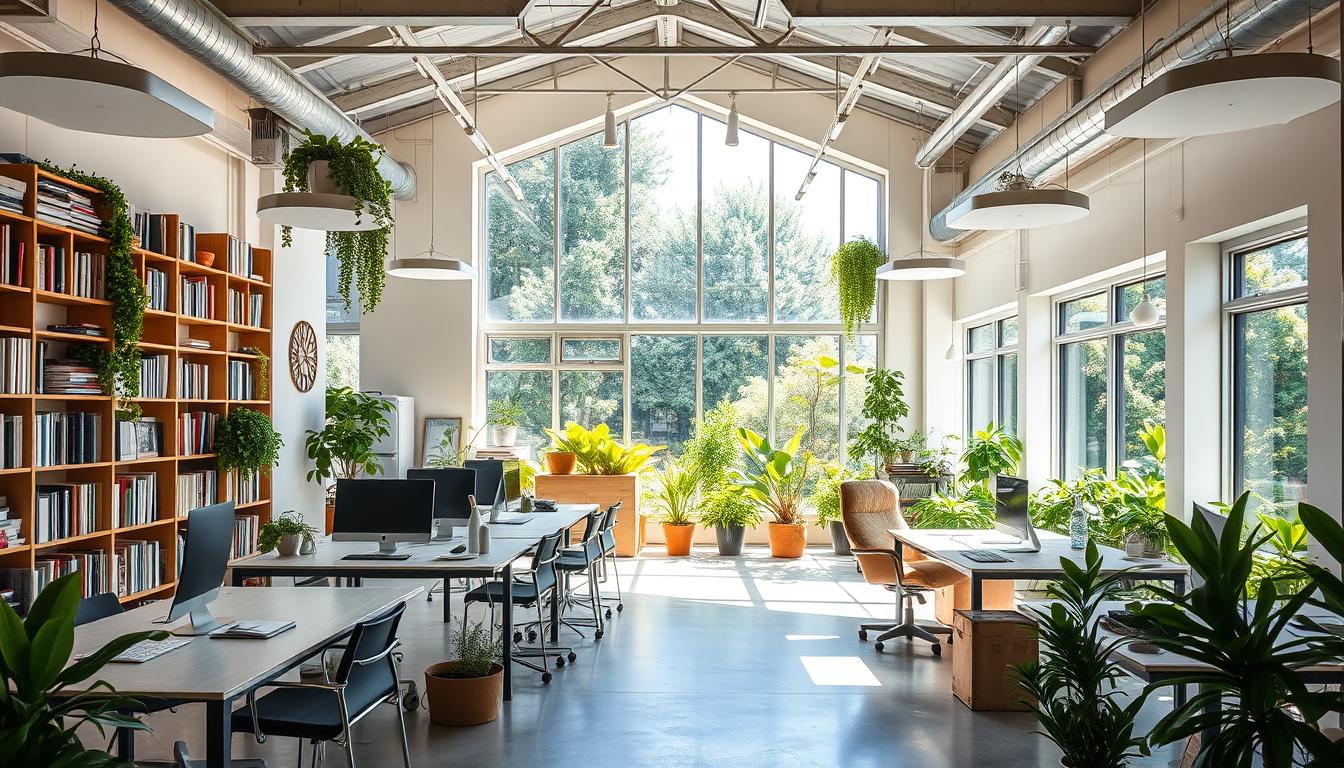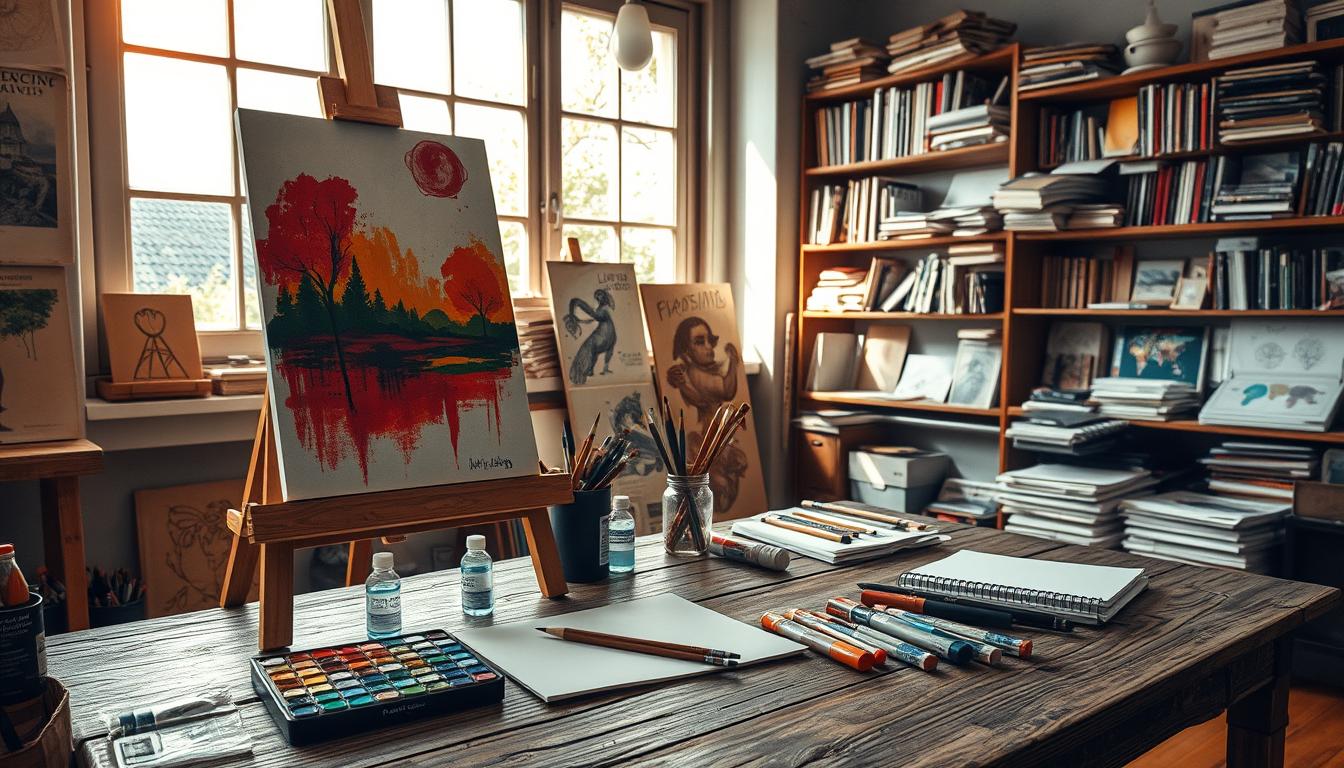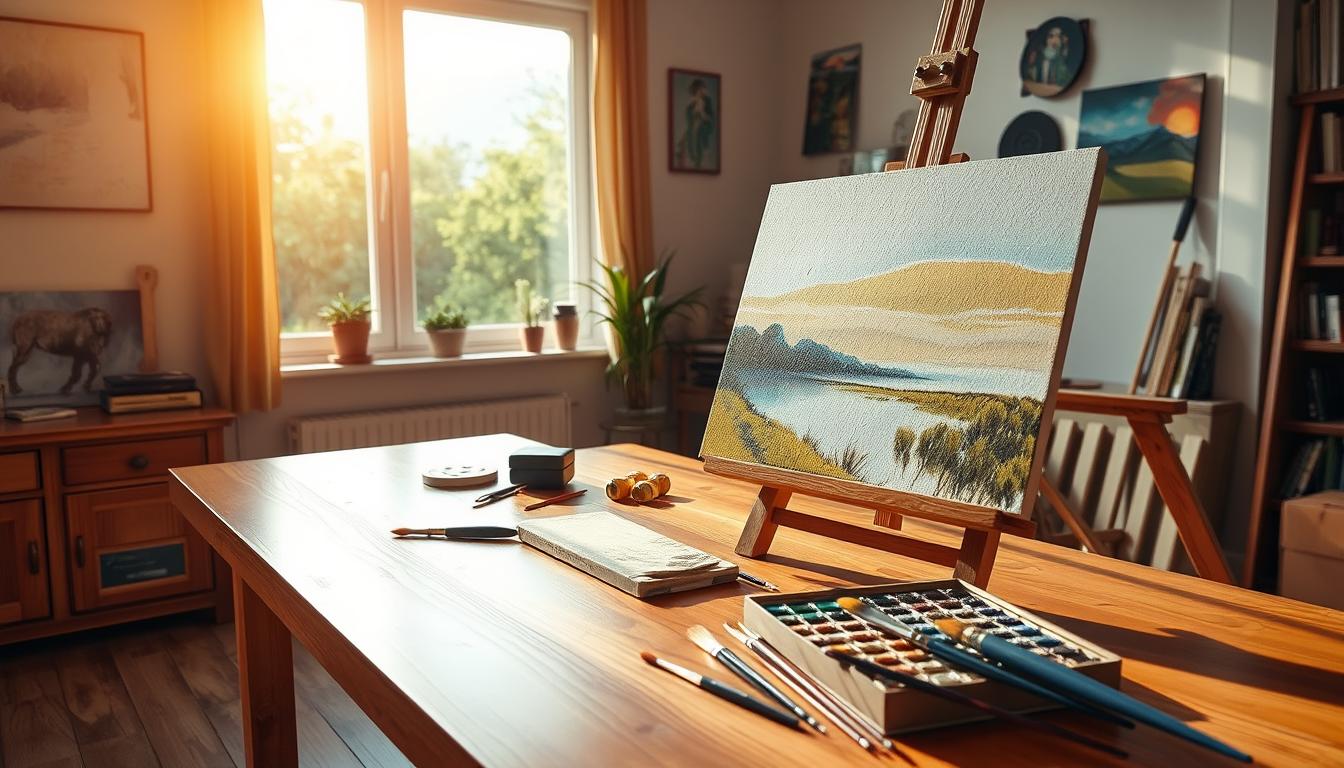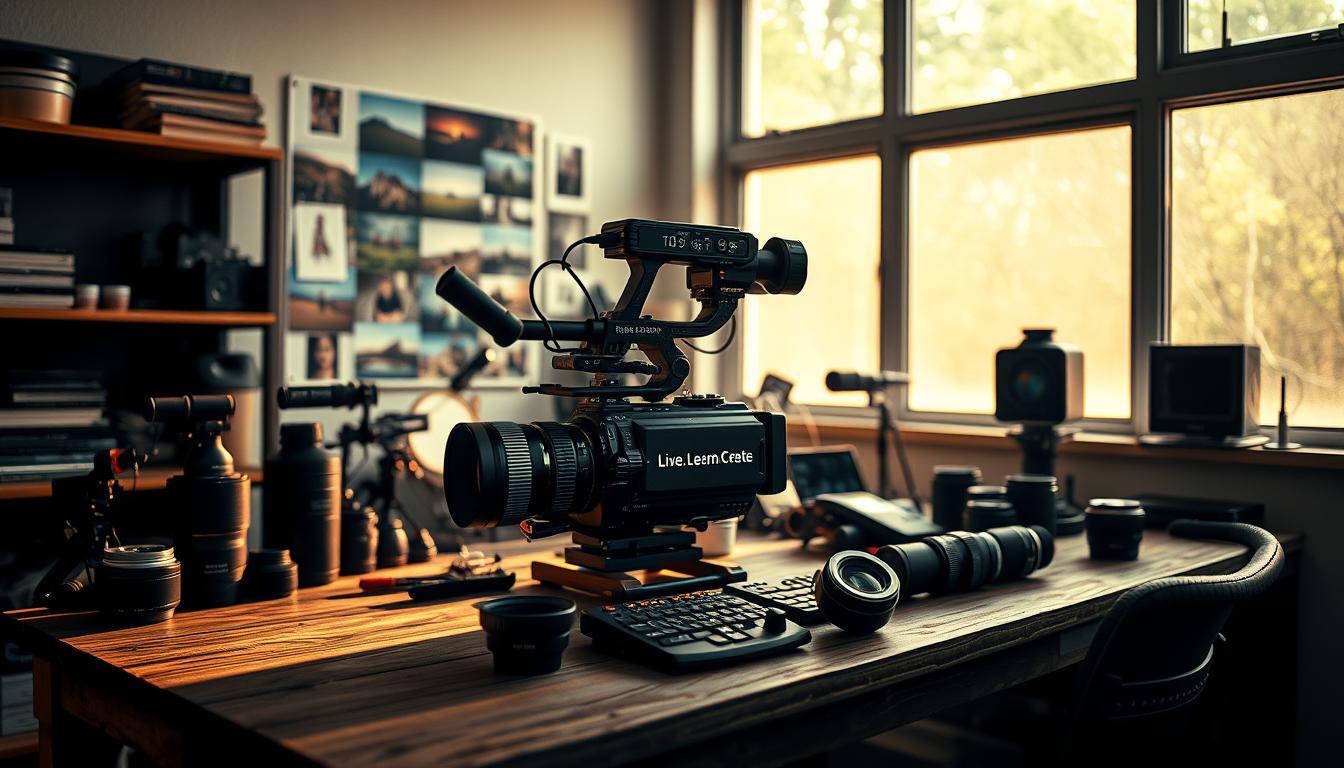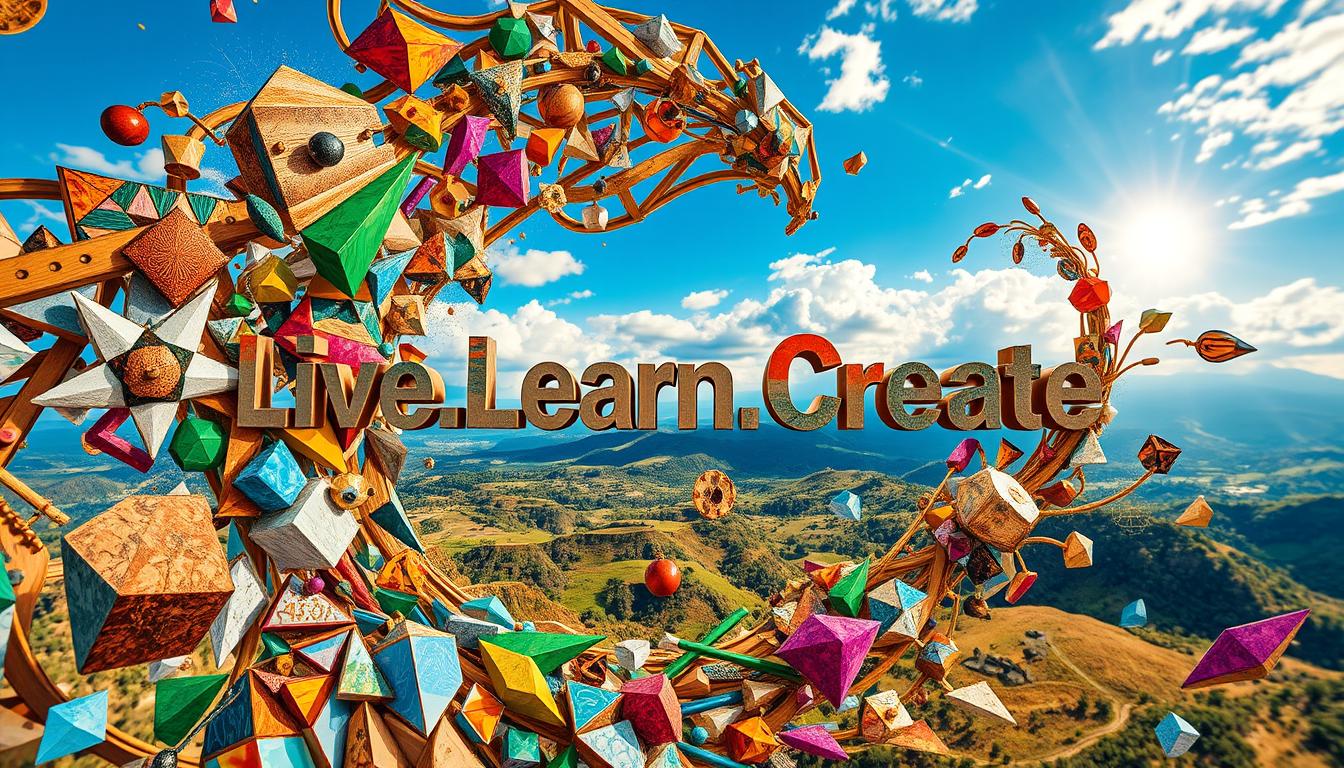Did you know the maker movement has sparked a new wave of DIY fans? With over 1,300 maker spaces globally, people get to use the latest tools and tech. These places are all about creativity, self-discovery, and teamwork, helping folks make their dreams come true.
As we dive into the world of maker spaces, we’ll see how these spots help people work together. They offer cool tools like 3D printers and laser cutters. This lets people bring their projects to life.
Maker spaces are great for those looking to grow and live mindfully. They’re places where people can learn, create, and innovate together. To learn more about the maker movement, check out https://livelearncreate.blog/blog/.
Key Takeaways
- Maker spaces are collaborative environments that foster creativity and self-discovery.
- These DIY hubs provide access to a wide range of tools and equipment, empowering individuals to turn their ideas into reality.
- Maker spaces promote personal growth, mindful living, and community engagement.
- They offer a welcoming environment for individuals to learn, create, and innovate together.
- The maker movement has inspired a new generation of DIY enthusiasts worldwide.
What Are Maker Spaces?
Maker spaces are collaborative workspaces that boost creativity and innovation. They are welcoming to everyone, with tools for all interests and skills.
These spaces are more than tools; they’re places for sharing ideas and working together. They help people learn by doing and grow as a community.
Definition and Purpose
Maker spaces are open and welcoming, offering many tools and technologies. They aim to spark creativity, innovation, and skill growth through hands-on learning and community involvement.
For more on maker spaces, check out https://livelearncreate.blog/blog/. It dives into the maker space world and its advantages.
Characteristics of Maker Spaces
Maker spaces have a few key traits:
- They offer a wide range of tools, from simple crafts to advanced tech like 3D printers.
- They foster a community spirit, encouraging sharing and learning.
- They focus on hands-on learning and experimentation, helping people develop new skills.
- They are open and welcoming, allowing everyone to join in, no matter their background or skill level.
By combining these traits, maker spaces create a special place for creativity, innovation, and personal growth.
The History of Maker Spaces
The history of maker spaces is tied to the DIY movement. This shows a move towards hands-on creativity and solving problems. The DIY spirit has driven the growth of maker spaces.
Origins in the DIY Movement
The DIY movement started with a focus on self-sufficiency and personal creativity. It encouraged people to create and fix things themselves. This movement helped create a culture of innovation and resourcefulness.
The DIY movement’s influence is clear in the early days of maker spaces. People came together to share tools, work on projects, and learn from each other.
Evolution Over the Years
Maker spaces have grown over time, adding new technologies and tools. They now include 3D printing, laser cutting, and digital fabrication. This growth has made maker spaces the lively places we know today.
| Year | Significant Event | Impact on Maker Spaces |
|---|---|---|
| 2000s | Emergence of DIY blogs and online forums | Increased sharing of DIY projects and tutorials |
| 2010s | Rise of maker faires and events | Growth of community engagement and networking |
| 2020s | Adoption of advanced technologies like AI and robotics | Enhanced capabilities for innovation and prototyping |
For more on this topic, visit https://livelearncreate.blog/blog/. It has resources and insights on maker spaces.
 to [laser cutters](https://www.amazon.com/dp/B07KXQRLVJ), where tinkerers, artists, and inventors come together to bring their ideas to life. In the foreground, an engineer intently focuses on a prototype, their face illuminated by the glow of a [smart workbench lamp](https://www.amazon.com/dp/B07XQXVXJV). The middle ground bustles with activity, as makers collaborate at communal tables, sharing knowledge and techniques. In the background, shelves of [maker-friendly electronics](https://www.amazon.com/dp/B07KXQRLVJ) and [crafting supplies](https://www.amazon.com/dp/B07BR3F9N6) hint at the boundless possibilities. The overall atmosphere is one of innovation, fueled by the "Live.Learn.Create" ethos that permeates these dynamic spaces. Maker spaces: bustling hubs of innovation and creativity. Sleek, modern workshops filled with an array of tools, from [3D printers](https://www.amazon.com/dp/B07BR3F9N6) to [laser cutters](https://www.amazon.com/dp/B07KXQRLVJ), where tinkerers, artists, and inventors come together to bring their ideas to life. In the foreground, an engineer intently focuses on a prototype, their face illuminated by the glow of a [smart workbench lamp](https://www.amazon.com/dp/B07XQXVXJV). The middle ground bustles with activity, as makers collaborate at communal tables, sharing knowledge and techniques. In the background, shelves of [maker-friendly electronics](https://www.amazon.com/dp/B07KXQRLVJ) and [crafting supplies](https://www.amazon.com/dp/B07BR3F9N6) hint at the boundless possibilities. The overall atmosphere is one of innovation, fueled by the "Live.Learn.Create" ethos that permeates these dynamic spaces.](https://livelearncreate.blog/wp-content/uploads/2025/08/Maker-spaces-bustling-hubs-of-innovation-and-creativity.-Sleek-modern-workshops-filled-with-1024x585.jpeg)
Maker spaces keep evolving, staying DIY hubs for creativity, innovation, and community. Knowing their history helps us see their importance in shaping the future of making and creating.
Benefits of Joining a Maker Space
Joining a maker space can change your life for the better. It offers many benefits for both personal and professional growth. You can learn new skills and meet people with similar interests in a supportive environment.
Skill Development Opportunities
Maker spaces are great for learning new skills. Through creative workshops and hands-on projects, you can try out woodworking, 3D printing, and coding. This lets you discover new hobbies and improve your current skills.
- Learn new technologies and techniques
- Enhance problem-solving skills
- Develop projects that showcase your creativity
Community Engagement and Networking
Maker spaces are lively collaborative workspaces. They are places where people come together, share ideas, and work on projects. This setting promotes networking and community involvement, helping you make lasting connections and collaborations.
Being part of a maker space means you can:
- Connect with like-minded individuals who share your interests
- Participate in group projects and events
- Gain insights from experienced makers and industry experts
Access to Specialized Tools
Another big plus of joining a maker space is getting access to specialized tools and equipment. You’ll find everything from 3D printers and laser cutters to sewing machines and woodworking tools. These resources help you turn your ideas into reality.
For more details on the benefits and opportunities of maker spaces, visit https://livelearncreate.blog/blog/.
Types of Maker Spaces
Maker spaces are places where creativity and innovation thrive. They can be found in many places, like community centers, schools, and even companies. Each one is unique, designed to spark imagination and problem-solving skills.
Community Maker Spaces
Community maker spaces are easy to find, often in libraries, community centers, or old factories. They are places where people can share ideas and learn from each other. For example, you might find classes on woodworking, electronics, or sewing.
Key features of community maker spaces include:
- Open access to tools and equipment
- Workshops and classes for all skill levels
- A place where innovation thrives
School and University Maker Spaces
Schools and universities are adding maker spaces to their programs. These spaces help with STEM education, creativity, and practical skills. University maker spaces also support student projects and startups, offering resources and guidance.
The benefits of educational maker spaces include:
- Learning through hands-on projects
- Collaboration among students from different fields
- Improving problem-solving and creativity
Corporate Maker Spaces
Companies are setting up maker spaces to boost innovation and creativity among their teams. These spaces have the latest technology and tools. They help in product development, employee engagement, and building a strong company culture.
 and a [Makita Oscillating Multi-Tool](https://amzn.to/3ZCsD4i) sit on a sturdy [Seville Classics UltraHD Workbench](https://amzn.to/3HWUXnI). In the middle ground, a [Cricut Maker 3](https://amzn.to/3ZGfZ8W) and a [Glowforge Plus Laser Cutter](https://amzn.to/3ZGfLe0) are set up on a workbench, with shelves displaying an array of materials and supplies. The background features a wall-mounted [Pegboard Organizer](https://amzn.to/3HWVwNR) showcasing a range of hand tools. Natural light streams in through large windows, creating a warm, inviting atmosphere. The "Live.Learn.Create" brand name is subtly present, reflecting the collaborative, educational nature of this maker space. A well-lit, airy maker space with an assortment of tools and equipment. In the foreground, a [Dewalt Cordless Drill](https://amzn.to/3ZDFVRf) and a [Makita Oscillating Multi-Tool](https://amzn.to/3ZCsD4i) sit on a sturdy [Seville Classics UltraHD Workbench](https://amzn.to/3HWUXnI). In the middle ground, a [Cricut Maker 3](https://amzn.to/3ZGfZ8W) and a [Glowforge Plus Laser Cutter](https://amzn.to/3ZGfLe0) are set up on a workbench, with shelves displaying an array of materials and supplies. The background features a wall-mounted [Pegboard Organizer](https://amzn.to/3HWVwNR) showcasing a range of hand tools. Natural light streams in through large windows, creating a warm, inviting atmosphere. The "Live.Learn.Create" brand name is subtly present, reflecting the collaborative, educational nature of this maker space.](https://livelearncreate.blog/wp-content/uploads/2025/08/A-well-lit-airy-maker-space-with-an-assortment-of-tools-and-equipment.-In-the-foreground-a-1024x585.jpeg)
Popular Tools and Equipment in Maker Spaces
Maker spaces are changing how we create, thanks to their advanced tools and equipment. These DIY hubs and creative workshops give people the tools to bring their ideas to life.
At the core of these spaces are machines and tools that spark innovation and creativity. Whether you’re experienced or new, knowing what’s available is key to reaching your creative peak.
3D Printers
The 3D printer is a major leap in maker technology. It lets users make complex three-dimensional objects from digital designs. This technology has opened up new ways to innovate and be creative.
- Create complex shapes that traditional methods can’t handle.
- Quickly test and refine your designs.
- Make custom parts and products easily.
Laser Cutters
Laser cutters are vital in many maker spaces. They use a powerful laser to cut through materials like wood, metal, and plastic. They’re perfect for making detailed designs and precise cuts.
- Make precise cuts through different materials.
- Design intricate patterns and shapes.
- Carve logos and text onto various surfaces.
Sewing Machines
Maker spaces also have traditional tools like sewing machines. These machines help makers make clothes, accessories, and home decor. They’re great for projects that need fabric work.
For more on maker spaces and their tools, check out https://livelearncreate.blog/blog/. It has more resources and insights.
How to Find a Maker Space Near You
Finding a maker space near you is now easier than ever. Online directories and local resources make it simple. Whether you’re experienced or new, finding the right workspace can boost your projects and creativity.
Online Directories and Resources
Online directories are a great way to find a maker space. Websites list maker spaces by location. Social media and forums also offer maker experiences and tips.
Key online resources include:
- Maker space directories on websites like MakerMap or TechShop
- Social media groups focused on maker culture
- Online forums and discussion boards
 and [Qtools 80-Piece Tool Set](https://www.amazon.com/dp/B09KK8T5J1) in the background. In the foreground, a group of people collaborating on a project using [Dewalt DW715 12-Inch Compound Miter Saw](https://www.amazon.com/dp/B0009T1YK4) and [Worx WX051 Clamping Workstation](https://www.amazon.com/dp/B077Y5LQTJ). Warm, natural lighting creates an inviting atmosphere. The "Live.Learn.Create" logo is displayed prominently, reflecting the collaborative and educational nature of the maker space. A well-lit, spacious maker space with a variety of equipment and tools. Shelves filled with [EVTSN 120-Piece Craft and DIY Tool Set](https://www.amazon.com/dp/B08L33QLKX) and [Qtools 80-Piece Tool Set](https://www.amazon.com/dp/B09KK8T5J1) in the background. In the foreground, a group of people collaborating on a project using [Dewalt DW715 12-Inch Compound Miter Saw](https://www.amazon.com/dp/B0009T1YK4) and [Worx WX051 Clamping Workstation](https://www.amazon.com/dp/B077Y5LQTJ). Warm, natural lighting creates an inviting atmosphere. The "Live.Learn.Create" logo is displayed prominently, reflecting the collaborative and educational nature of the maker space.](https://livelearncreate.blog/wp-content/uploads/2025/08/A-well-lit-spacious-maker-space-with-a-variety-of-equipment-and-tools.-Shelves-filled-with-1024x585.jpeg)
Local Libraries and Community Centers
Local libraries and community centers are also great resources. Many libraries have maker spaces with tools like 3D printers. Community centers offer maker spaces for everyone.
When visiting local libraries or community centers, be sure to ask about:
- Availability of maker spaces and their equipment
- Workshops or classes offered for makers
- Membership or access requirements
For more information, visit https://livelearncreate.blog/blog/. It has resources and guides on maker spaces.
Setting Up Your Own Maker Space
Creating your own maker space needs careful planning. You must understand what your community needs. This effort will turn your space into a lively place for DIY fans and innovators.
Key Considerations for Space Design
Designing your maker space involves several key factors. The layout should encourage teamwork and creativity. Think about the space’s flow, lighting, and atmosphere.
Make sure your space has areas for woodworking, electronics, and crafting. Use flexible furniture and equipment to support different projects and events.
Essential Tools and Supplies
The tools and supplies you choose depend on your space’s focus. A general-purpose space might have hand tools, power tools, and special equipment like 3D printers and laser cutters.
Keep a variety of materials ready, such as wood, metal, fabric, and electronics parts. Building relationships with suppliers can help you get these materials efficiently.
| Tool/Supply | Purpose | Initial Cost |
|---|---|---|
| 3D Printer | Prototyping and production | $1,000-$5,000 |
| Laser Cutter | Precision cutting | $2,000-$10,000 |
| Sewing Machines | Textile projects | $500-$2,000 |
Budgeting and Funding Options
Creating a budget is key for your maker space. Consider startup costs, ongoing expenses, and ways to make money.
You can fund your space through membership fees, grants, sponsorships, and hosting events. A solid financial plan is vital to meet your community’s needs and manage costs.
For more tips on setting up a maker space, check out https://livelearncreate.blog/blog/. It offers resources and advice.
Maker Space Etiquette and Best Practices
When you join a maker space, knowing the rules is key. These places value respect and safety. Everyone must follow guidelines and respect others while working.
Sharing Equipment Responsibly
Sharing tools is a big part of maker space etiquette. Be considerate of others who might need the same tools. Always clean and maintain equipment after use, and be ready to share complex tools like 3D printers or laser cutters.
If you’re using a 3D printer for a long time, let others use simpler tools. This builds goodwill and makes sure everyone gets a turn.
Collaborating with Others
Maker spaces are all about working together. It’s important to be open, respectful, and willing to share. Don’t hesitate to ask for help or offer it when needed.
Working together can lead to great ideas and new friends. You might start a project alone but find a partner who adds something special, making the project better.
Safety Guidelines
Safety is the top priority in maker spaces. Learn the safety rules and emergency plans. Always wear the right safety gear, like goggles and gloves, when using machines. Know where the first aid kits and exits are.
For more on maker space etiquette and best practices, check out https://livelearncreate.blog/blog/. It has lots of resources and insights from the maker community.
![A modern collaborative workspace with an open, airy layout. Bright natural light streams through large windows, illuminating a mix of ergonomic workstations, lounge areas, and creative zones. Live plants and minimalist decor create a calm, focused atmosphere. In the foreground, a group of people work together around a [Live.Learn.Create] standing desk, exchanging ideas and sketching on a digital whiteboard. In the background, smaller breakout rooms offer privacy for individual tasks or team meetings. The overall scene radiates productivity, creativity, and a sense of community. A modern collaborative workspace with an open, airy layout. Bright natural light streams through large windows, illuminating a mix of ergonomic workstations, lounge areas, and creative zones. Live plants and minimalist decor create a calm, focused atmosphere. In the foreground, a group of people work together around a [Live.Learn.Create] standing desk, exchanging ideas and sketching on a digital whiteboard. In the background, smaller breakout rooms offer privacy for individual tasks or team meetings. The overall scene radiates productivity, creativity, and a sense of community.](https://livelearncreate.blog/wp-content/uploads/2025/08/A-modern-collaborative-workspace-with-an-open-airy-layout.-Bright-natural-light-streams-1024x585.jpeg)
Success Stories from Maker Space Participants
Maker spaces are more than just places to work. They are where innovation meets personal growth. Here, people with different skills and interests come together. This mix has led to amazing success stories.
Innovative Projects and Ventures
Many makers have started projects that could change the world. For example, a group might work on a low-cost prosthetic limb with 3D printing. These projects show the power of collaboration.
“The maker movement has given rise to a new generation of innovators, with maker spaces serving as incubators for their projects.” –
Some projects that stand out include:
- Developing sustainable energy solutions
- Creating assistive technology for people with disabilities
- Designing and prototyping new products using advanced manufacturing techniques
Personal Growth and Learning Experiences
Maker spaces do more than just spark innovation. They also help people grow and learn. Participants gain new skills, build confidence, and find a sense of community.
| Skill Developed | Percentage of Participants |
|---|---|
| 3D printing and design | 60% |
| Coding and programming | 50% |
| Woodworking and carpentry | 40% |
For more on the maker movement, visit https://livelearncreate.blog/blog/.
The stories of those who’ve been part of maker spaces are inspiring. These spaces offer tools, expertise, and a place to work together. They help people bring their ideas to life and grow personally.
Educational Programs Offered by Maker Spaces
Maker spaces give people access to creative workshops and DIY hubs. They help create a new generation of innovators. These programs focus on skill development, creativity, and community involvement.
Maker spaces have many educational programs. They range from hands-on learning to partnerships with local schools. These programs are for all ages and interests, making sure everyone can learn and grow.
Workshops and Hands-On Learning
Maker spaces are known for their workshops and hands-on learning programs. These sessions let people learn by doing, gaining new skills and applying what they know in real life.
- Woodworking and carpentry classes
- Electronics and robotics workshops
- 3D printing and design sessions
- Coding and programming classes
For example, a local maker space might have a workshop on 3D printing. Participants learn to design and print their own models. These experiences improve technical skills, boost creativity, and encourage innovation.
Partnerships with Local Schools
Maker spaces also team up with local schools. They add their educational programs to the school curriculum. This partnership lets students use maker space resources and learn from experts. It makes learning more engaging and prepares students for STEM careers.
| Benefits | Description |
|---|---|
| Enhanced Learning Experience | Access to maker space resources and expertise |
| Skill Development | Opportunities for hands-on learning and project-based education |
| Community Engagement | Fostering collaboration between students, educators, and industry professionals |
As
“Maker spaces are becoming an integral part of the educational ecosystem, providing students with the skills and knowledge needed to succeed in an increasingly complex and technological world.”
For more details on maker space educational programs, visit https://livelearncreate.blog/blog/.
 equipped with [sewing machines](https://www.amazon.com/SINGER-Start-1304-Sewing-Machine/dp/B00094KXQI/), [3D printers](https://www.amazon.com/Creality-Ender-3-V2-Printer/dp/B07XQJXZC7/), and [laser cutters](https://www.amazon.com/Orion-Motor-Tech-Engraver-Engraving/dp/B07XKBQKC2/). In the middle ground, individuals work on [pottery wheels](https://www.amazon.com/VEVOR-Electric-Pottery-Throwing-Ceramic/dp/B07X2NFHFK/) and [woodworking tools](https://www.amazon.com/DEWALT-DW735X-13-Inch-Two-Speed-Thickness/dp/B00062YVXK/). The background features a [large display board](https://www.amazon.com/Corkboard-Bulletin-Pinboard-Whiteboard-Combination/dp/B08RVJB3GR/) with sketches, plans, and the Live.Learn.Create logo. A well-lit, modern makerspace with an array of creative tools and workshops. In the foreground, a group of students gather around a [large wooden worktable](https://www.amazon.com/VIVO-Electric-Height-Adjustable-Workbench/dp/B07Q1DJJ6J/) equipped with [sewing machines](https://www.amazon.com/SINGER-Start-1304-Sewing-Machine/dp/B00094KXQI/), [3D printers](https://www.amazon.com/Creality-Ender-3-V2-Printer/dp/B07XQJXZC7/), and [laser cutters](https://www.amazon.com/Orion-Motor-Tech-Engraver-Engraving/dp/B07XKBQKC2/). In the middle ground, individuals work on [pottery wheels](https://www.amazon.com/VEVOR-Electric-Pottery-Throwing-Ceramic/dp/B07X2NFHFK/) and [woodworking tools](https://www.amazon.com/DEWALT-DW735X-13-Inch-Two-Speed-Thickness/dp/B00062YVXK/). The background features a [large display board](https://www.amazon.com/Corkboard-Bulletin-Pinboard-Whiteboard-Combination/dp/B08RVJB3GR/) with sketches, plans, and the Live.Learn.Create logo.](https://livelearncreate.blog/wp-content/uploads/2025/08/A-well-lit-modern-makerspace-with-an-array-of-creative-tools-and-workshops.-In-the-foreground-1024x585.jpeg)
The Future of Maker Spaces
The future of maker spaces is bright and full of possibilities. The maker movement keeps growing, with new tech and trends popping up all the time. This growth isn’t just about the tools; it’s also about creating innovation and building community.
Trends to Watch
Several trends are shaping the future of maker spaces. One big trend is adding digital tech like AI and IoT to maker spaces. This lets makers work on more complex projects. Another trend is focusing on being green and caring for the environment.
Sustainability is becoming a key part of maker spaces. Many are now using eco-friendly practices and materials. This helps the planet and inspires makers to think of new ways to reduce waste and reuse stuff.
How Technology is Shaping the Maker Movement
Technology is a big player in the maker movement. New tools like 3D printing and laser cutting open up new possibilities. Online platforms and digital tools also help makers share ideas and work together from anywhere.
Virtual and hybrid maker spaces are also on the rise. They let people work together from different places. As tech keeps getting better, maker spaces will keep getting more creative and welcoming to everyone.
For more info on maker spaces and their future, check out this website.
Getting Involved in the Maker Movement
Joining the maker movement can be very rewarding. It lets you connect with a community that loves creativity and new ideas. DIY hubs and hands-on learning places offer many chances to grow and learn.
Volunteer Opportunities
Volunteering at a local maker space is a great way to get involved. It helps the community and lets you learn new things. Plus, you get to meet people who share your interests.
Participating in Maker Fairs and Events
Maker faires and events are also excellent ways to join in. They highlight cool projects and let makers show off their work. For more info, check out this website.
FAQ
What is a maker space?
A maker space is a place where people work together. It has lots of tools and equipment. Here, you can learn by doing and make your ideas real.
What are the benefits of joining a maker space?
Being part of a maker space has many perks. You can learn new skills, meet others, and use special tools. It’s a place where creativity and growth are encouraged.
What types of tools and equipment are typically available in maker spaces?
In maker spaces, you’ll find tools like 3D printers and laser cutters. These help you make your ideas into real things. It’s a place for hands-on learning and creating.
How do I find a maker space near me?
To find a maker space near you, search online or check local libraries and community centers. They often have info on maker spaces and places to work together.
What should I consider when setting up my own maker space?
Setting up your own maker space? Think about the space design, tools, and budget. You want a place that supports creativity and innovation.
What are some best practices for using a maker space?
To make the most of a maker space, share tools well, work together, and follow safety rules. This makes it a welcoming place for everyone.
Can maker spaces be used for educational purposes?
Yes, maker spaces are great for learning. They offer programs for all ages and often work with schools. It’s a place for education and skill-building.
How can I get involved in the maker movement?
To join the maker movement, volunteer, go to maker events, or share your skills. This helps grow the maker community.
Transform your home into a more peaceful and mindful sanctuary. Creating a Zen-inspired home environment is a core part of the “Live.Learn.Create” theme, focusing on peace, mindfulness, and a clutter-free space. Here is a curated list of Zen home items.
The Zen Essentials
These items are the building blocks of a calm, intentional living space.
- Candles & Scents:
- Scented Candles: Look for calming, natural scents like sandalwood, lavender, white tea, or bergamot. Choose candles made with soy or beeswax for a clean burn.
- Essential Oil Diffusers: A minimalist, sleek diffuser made of bamboo, ceramic, or glass.
- Essential Oil Sets: Look for blends specifically for relaxation, focus, or sleep.
- Incense & Burners: Natural incense sticks (e.g., palo santo, sage) with a simple, elegant burner.
The Zen Decor
This is about incorporating natural elements and simple design.
- Natural Materials:
- Wood or Bamboo Trays: For organizing candles, stones, or other small items.
- Ceramic Vases: Simple, unglazed ceramic vases in neutral colors like white, beige, or gray.
- Minimalist Art: Simple line drawings, abstract prints, or nature-inspired artwork.
- Hand-Carved Stone Coasters: Or other small stone sculptures.
- Textiles:
- Linen or Cotton Throws: A soft, neutral-colored throw blanket to add warmth.
- Jute or Sisal Rugs: These add natural texture and grounding to a space.
- Meditation Cushions (Zafu) & Mats (Zabuton): These provide comfort for meditation and add a serene touch to a room.
The Zen Ambiance
These items help create a peaceful sensory experience.
- Lighting:
- Himalayan Salt Lamps: These provide a warm, soft glow.
- Japanese-style Paper Lanterns: For a soft, diffused light source.
- Dimmable Smart Bulbs: To easily control the warmth and brightness of your lighting.
- Sound:
- Tabletop Water Fountains: The gentle sound of running water is incredibly calming.
- Wind Chimes: Made from natural materials like bamboo or metal for a soft sound.
- Bluetooth Speakers: Small, aesthetically pleasing speakers for playing ambient or meditation music.
- Nature:
- Bonsai Trees or Air Plants: Low-maintenance indoor plants that bring life and a touch of nature indoors.
- Zen Gardens: A small, tabletop sand garden with a rake and stones for a meditative ritual.
- Decorative Rocks & Pebbles: For bowls or as a decorative element.
Best Sellers https://amzn.to/3Vet1tI
New Releases https://amzn.to/4mwLjTi
Amazon Movers & Shakers https://amzn.to/4fPsZlP
Mindfulness Coloring Books https://amzn.to/4fQ0wMx
Personal Growth Coloring Books https://amzn.to/4lJeRf0
Health & Wellness https://amzn.to/4oRt24C
Zen Home Decor https://amzn.to/3VeA3i6
Zen Garden Decor https://amzn.to/4mXjT8D
Zen Garden https://amzn.to/3HQTVVB
- Mindfulness & Meditation:
- Physical Wellness:
- Habit & Productivity Tools:
- Books:
- Best-selling personal development books (Mindset, The 7 Habits of Highly Effective People, The Subtle Art of Not Giving a F*ck)
- Books on a variety of skills (coding, photography, writing.)
- Educational Gadgets:
- Smart pens that digitize notes (e.g., Rocketbook)
- Portable scanners for digitizing documents
- Laptops, tablets, and accessories
Create (Creativity, Innovation, Projects)
These products cater to your creative side, whether you are a artists, writer, or DIY enthusiasts.
- Creative Supplies:
- Adult coloring books or “paint-by-sticker” books
- Craft kits (e.g., candle-making, pottery, embroidery)
- Digital Creation Tools:
- General Inspiration & Making:

